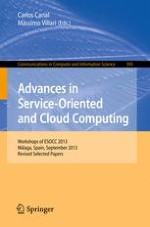This book contains the proceedings of the five high-quality workshops organized at the Second European Conference on Service-Oriented and Cloud Computing, ESOCC 2013, held in Malaga, Spain, in September 2013. The workshops are: Cloud for IoT (CLIoT 2013), CLOUd Storage Optimization (CLOUSO 2013), 12th International Workshop on Foundations of Coordination Languages and Self-Adaptive Systems (FOCLASA 2013), First Workshop on Mobile Cloud and Social Perspectives (MoCSoP 2013), and the 3rd International Workshop on Adaptive Services for the Future Internet (WAS4FI 2013). The 29 papers presented were carefully reviewed and selected from 51 submissions. They focus on specific topics in service-oriented and cloud computing domains: cloud environments, smart connectivity, context-aware computation, cloud for IoT, storage clouds, coordination languages, formal approaches to modeling and reasoning, self-systems, services for mobile devices, wireless sensor networks.
